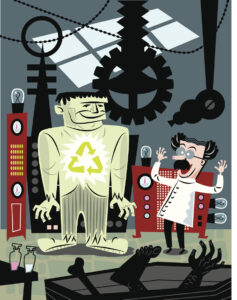On April 24, 1985, President Ronald Reagan broadcast a live address to the nation on a topic he believed to be of the utmost importance: the need to save future generations from the consequences of excessive government overspending. “The threads of our past, present, and future as a nation will soon converge on the single overriding question,” he began. “Can we at last, after decades of drift, neglect, and excess, put our fiscal house in order?” Most living Americans “won’t see the damage that our growing debt will cause in the future,” Reagan conceded, but their successors inevitably will.
In the nearly 40 years since the president’s Oval Office speech, neither the overspending problem he warned about nor the conservative plea to spare coming generations from its fiscal consequences has changed. But precisely because the country has become so accustomed to both, an important demographic shift has gone largely unappreciated. As the inevitable budgetary reckoning has gotten closer, those once-distant descendants we condemned to suffer for our profligacy are not so distant anymore.
According to the Treasury Department’s most recent Financial Report of the U.S. Government, Washington will have to begin covering Medicare’s projected $9.5 trillion deficit in just seven years and an even larger Social Security liability of $68.8 trillion in ten. Add to these grim figures the fact that the current federal debt of $34.4 trillion jumps by one trillion every 100 days, and the coming mix of higher taxes and lower benefits is no longer measurable in decades or perhaps even years.
“It’s not like the U.S. needs to pay off the entire mountain of debt right away,” explains JPMorgan CEO Jamie Dimon. But the country is “going 60 miles an hour” toward a fiscal cliff and action needs to be started “now” to prevent a financial catastrophe.
It is still too early to know exactly which age groups will be the first since the Great Depression to experience a significantly diminished lifestyle or how far downward their expectations will have to be adjusted. Much depends on whether the U.S. can keep selling its debt at reasonable interest rates, the level of defense spending eventually needed to counter foreign adversaries, and the extent to which an unforeseen technological breakthrough or two might cushion at least some of the nation’s economic decline.
But, as the recently publicized Gallup survey on world happiness (in conjunction with Oxford University and other partners) makes clear, those Americans on the low side of 30 already know they are going to pay a big price for their elders’ lengthy joy ride. The U.S. drop to the 23rd happiest country after the United Arab Emirates is due in large part to the pervasive pessimism among its younger citizens that they will ever do as well economically as their parents. They can see, as the late Berkshire Hathaway co-founder Charlie Munger put it, that they’ll have to “get used to making less.”
For the federal debt alone, today’s young have every right to be angry. After all, it’s not like their predecessors lacked enough warning about where the government’s undisciplined spending would eventually lead or sufficient time to do something about it. For all their moralistic talk about “saving their grandchildren and great grandchildren” from a preventable economic crisis, those who came before did little to stop it.
Excessive government debt is not the only unfair burden inflicted on today’s rising generations by their self-indulgent elders. When, for example, the coronavirus pandemic struck, the country’s K-12th grade public educators, who should have been working overtime to keep their students’ minds stimulated, instead lobbied to close the nation’s schools as long as possible. This despite the evidence, even early on, that only seniors and those with preexisting medical conditions had anything serious to fear from the virus.
According to studies from the Brookings Institute and the Harvard Center for Educational Policy Research, the gap in students’ academic and emotional development which occurred during the lengthy shutdowns was not an easily correctable delay, but a psychological impairment which will plague many for the rest of their lives. Once more, it was widespread, impacting whole communities, regardless of student race or income.
Sadly, public school teachers and administrators have not been the only educators to exploit the country’s young. For decades, colleges and universities have peddled the self-serving myth that going heavily into debt for a four-year degree is a “can’t lose” investment in the future. And not just if one majors in some promising branch of science or technology, but in a subject like gender studies, social justice, or even the history of television.
At the heart of today’s $1.727 trillion student debt crisis is not only the fact that many of those wrongly persuaded to go to college or university never graduated, but that those who did are not getting anywhere near the promised return on their tuitions. A February report from the Burning Glass Institute and the Strada Education Foundation finds that more than half of today’s graduates end up in jobs where their degrees are not needed and that most will remain underemployed for the rest of their careers.
And then there are the left-wing activists who, in their single-minded pursuit of a carbon-free world, have had no problem mobilizing the support of young people with end-of-the-world predictions based on false and sloppy scientific research. The result, according to a 2021 survey by Lancet Public Health, is that 59 percent of today’s 16- to 25-year-olds are “very or extremely” worried about climate change. And nearly half say they cannot function normally because of atmospheric related anxieties.
Add the neglect of students’ developmental needs during Covid, the financially exploitative behavior of colleges and universities, and green scare tactics to America’s irresponsible accumulation of public debt, and is it any wonder that the suicide rate among older teens and young adults has spiked to historic highs? Or that by nearly every metric, instances of anxiety, depression, and stress among these age groups are also higher than they have ever been?
Nor should we be surprised that many young people have found some relief from their seemingly dreary prospects in the woke reincarnation of Marxism—a redistributionist ideology that may not offer a better future, but at least an equal share of whatever the future turns out to be. Unfortunately, it also undermines the values which are most likely to save the country from its fiscal problems: self-reliance, ambition, and a belief in the nation’s founding principles.
However today’s younger generations finally manage the weak economic hand we’ve dealt them, those of us in the second half of life can only hope they show more consideration for our well-being than too many of our contemporaries were ever willing to show for theirs.





